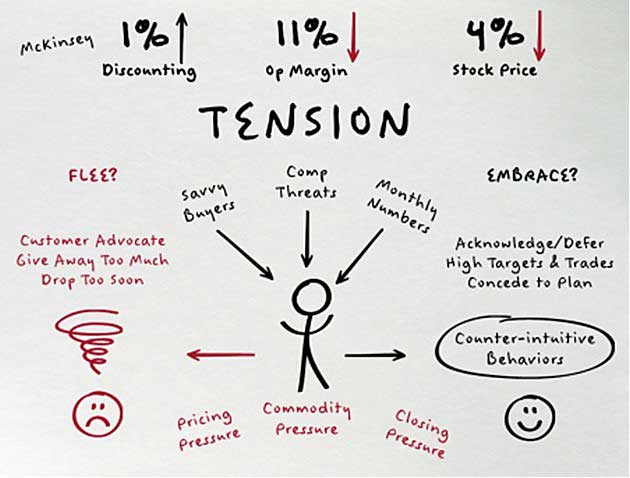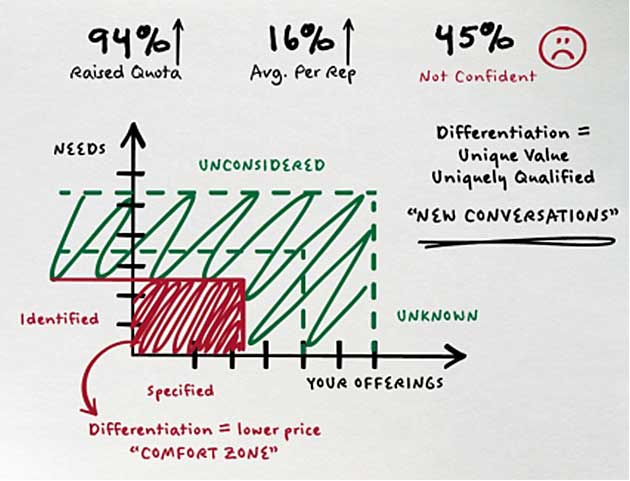Companies looking for more profitable growth often turn to the following three common strategies. But each has a major flaw that causes you to continue leaking precious margin. Do any of these sound familiar?
1. Pricing and discount strategies: You've developed new pricing policies, you've rearranged the compensation plan to encourage more profitable deals, and you've even started aggressively tracking and reporting discounts, but you are still discounting too much.
2. Sales process and methodology: You've installed a consistent set of sales steps to follow, applied more discipline to your sales cycles, and embedded those steps into your CRM, but you haven't seen the uptick in business you were promised.
3. Customer acquisition and expansion: You've put more resources into demand generation campaigns and you've built opportunity management and account planning playbooks, but you are still selling the same stuff to the same people.
The rest of this article looks at why you're struggling to get results from these strategies and provides counterintuitive ideas for making each one more effective.
Discount Strategies: Embrace the Tension, Don't Flee It
The reason operational changes in discount policies, comp plans, and software analytics haven't fixed the problem is that discounting is a people problem—more specifically, your people's reaction to the tension they face in sales cycles.
Where does that tension come from? Well, your buyers are savvier than ever. They are professional and well-trained to push hard to get you to talk about price before you've built value, and make you give up more points than you want on every deal. Your competitors are getting tougher. Some are willing to give business away just to steal your market share. And every month there's the pressure to close as many deals as possible.
The typical, intuitive response of most salespeople who find themselves in this tension is to flee from it as fast as possible to make it go away. Their intuition says, "Hey, my role is to be the customer advocate, so I need to help them get the best deal possible, keep the relationship smooth and friendly, and do it fast to keep my manager off my back."
What's the predictable result? Well, your salespeople flee to the comfort of product giveaways, service giveaways, and other giveaways that erode not only the bottom line but also your customer's perception of your value. Or, they default to the lowest allowed discount rate too soon.
Counterintuitive idea No. 1: Acknowledge that price is an issue, but gain your buyer's agreement to defer the issue until an appropriate time in the sales cycle when you've been able to identify and confirm all needs with all key stakeholders and align an appropriate solution in response to those needs. This approach buys the time necessary to build enough value. If you are forced to "give a number" too early, you need to be willing to set higher targets, and explain that the figure will be tightened as you learn more specifics. Give yourself the flexibility later to provide some concessions without defaulting to the lowest price.
Speaking of concessions, you should concede to a plan. Be prepared to get something back from your buyer if/when you need to give something up. Identify specific trades you can offer in exchange for concessions you are asked to make. Pre-designed trades enable your salespeople to act with confidence and authority, which is critical to success in the face of pricing pressure. Document those trades in confirmation letters that are approved by you and your customer and included as part of the opportunity.
Also, consider training your salespeople on the skills and models that arm them to manage tension and take control of the customer conversation.
Sales Process: Get Agreements—Don't Just Check Boxes
Sales processes are typically very well engineered. The idea is that as you move through the steps of the process you're supposed to be demonstrating value to the customer. And by the time you reach the end of the process the customer will see that you're worth your price. Or so the theory goes.
However, if you're like most organizations, every time your salespeople move an opportunity to the next step in your CRM system, it becomes more of a "check the box" exercise than a value-creation one. Step one: "I'm there, boss!" Step two, "I'm there, boss!" and so on. The boxes are checked, the pipeline grows, but what happens at the end? Close rates are down, "no decisions" are up, pricing battles turn into wars, and profitability suffers.
What's really happening here? Your sales team is managing opportunities to a checkbox, step-by-step sales process of prescribed and requested activities, without getting any agreement from the prospects or customers that the process is actually moving forward or that they see enough value to commit to the next steps.
What's the result? You give away pre-sales consulting without getting anything in return. You provide insight without getting anything in return. You do product demonstrations without getting anything in return. You deliver a proof of concept without getting any commitment for next steps. Or, worse, you burn up reference customers without getting any assurances for the effort.
Counter-intuitive idea No. 2: Each of these moments is an opportunity to craft what we call "pivotal agreements," which are key moments early in the sales cycle that lead to bigger, more profitable deals later on. What if you asked for something in return for every action you performed on your customer's behalf? What if you got your decision-maker to agree to something that demonstrated real progress in the buying cycle? What if you were exchanging value instead of just giving... and giving some more?
Pivotal agreements are pre-planned, purposeful exchanges of value at each step of the buying process. For example, in exchange for bringing in one of your subject matter experts, you get them to agree to bring key stakeholders who will be signing off on any deal. Or, if a site visit or reference check is required, get agreement for something important in return, such as access to all of the data you will need to prepare a more complete and accurate ROI or TCO calculation for the business case.
Here's the bottom line: replace the checkbox of activities in your sales process with more meaningful, value-exchanging conversations and agreements with your customers so you get something in return for the things you give up to advance the sale.
Acquisition and Expansion: Provoke Unconsidered Customer Needs
New logo acquisition and customer cross-sell expansion plans tend to neglect one important thing. You are typically asking salespeople to have a new kind of conversation, with new decision-makers, about new needs and new products and services they aren't comfortable with.
If your salespeople are like most others, they are in their "comfort zones" when talking to buyers about common needs they already know so they can sell them familiar solutions. Often these customers have done their homework and are pretty prescriptive about what they want and provide your salespeople with a list of identified needs and specified capabilities.
This is a very comfortable conversation for most reps. Your salespeople align the best-fit product from your portfolio that matches the customer's stated needs and specs… and voila: You've got an opportunity created and weighted in your pipeline.
Here's the problem: This comfort zone is really a trap. In the land of identified needs and specified products are a lot of competitors with very similar offerings, and your buyers are shameless about calling in the competitive providers for comparison. In this comfort zone, the only differentiator left is price.
If your salespeople are selling in this "comfort zone," your prospects won't sense enough contrast to give up the incumbent competitor, and your existing customers will keep your salespeople busy buying the same stuff, which puts your new logo acquisition and relationship expansion plans at risk.
Counter-intuitive idea No. 3: The real opportunity to create legitimate new business—with both prospects and customers—is to identify additional "net new" needs that your buyers didn't really suspect were important, or imminent, or valuable. And, introduce capabilities to address those new needs and create unexpected, new value.
These "unconsidered" needs are the ones that will allow you to introduce these "unknown" capabilities. And, it's at this intersection of unconsidered and unknown that will put you in a position of offering unique value to your buyers—with capabilities you are uniquely qualified to offer.
These are new conversations, about new needs and new solutions with new decision makers. They are different and challenging, and they are outside the typical sales rep's comfort zone.
As a result, they don't happen by accident. They are the product of a cross-functional effort to develop provocative messages around unconsidered needs. Then build contextual value stories around how your unknown capabilities resolve those unconsidered needs.
Finally, you must put this unique, new content into equally distinctive selling tools that break through the clutter, such as visual stories delivered in consultative conversations on a whiteboard or flip chart. And, finally, you must get your salespeople to practice these new conversations, and get your managers to coach to these new kinds of customer interactions, until they are able to escape from their comfort zone.
Prioritize and Plug
That's a quick look at three typical growth strategies where you are leaking value, and three counter-intuitive ideas for making you more profitable. Prioritize which of these areas needs the most help and begin looking for ways to introduce these ideas to plug the holes.








